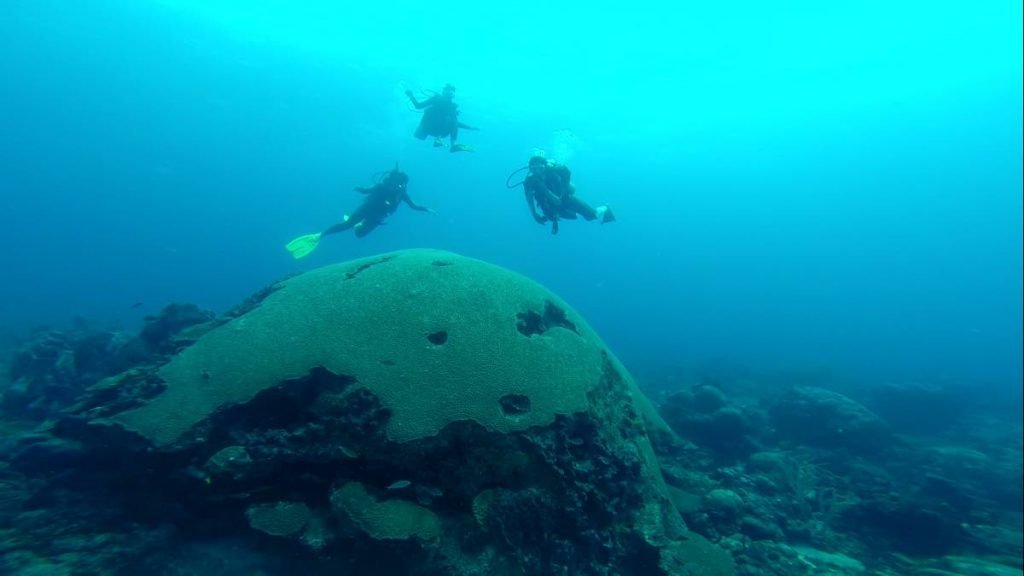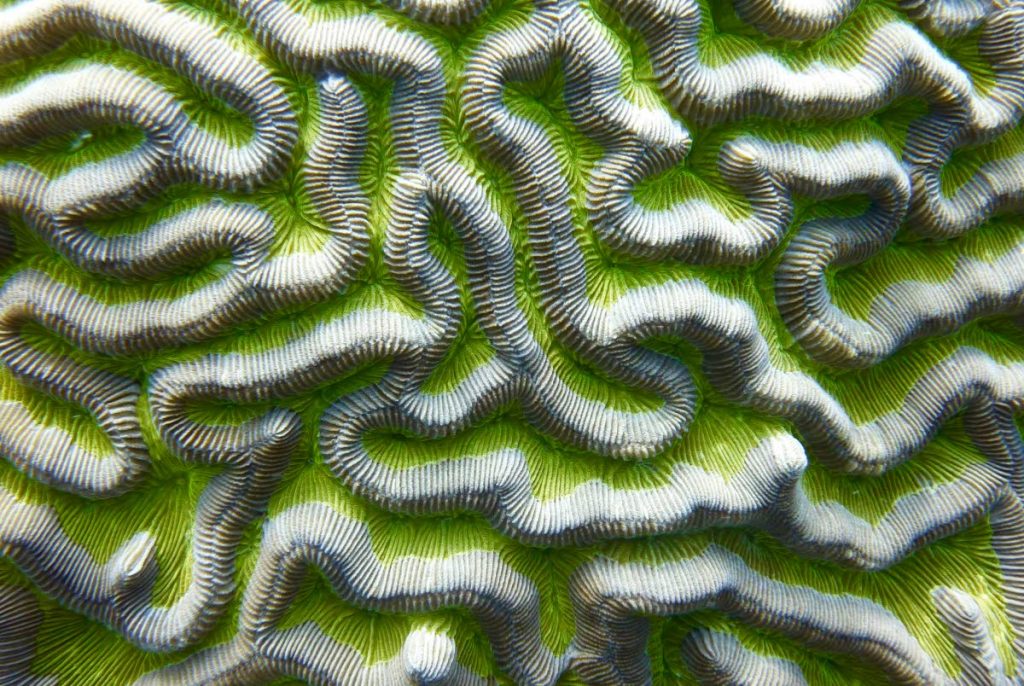Tobago’s timekeeper

Marine biologist ANJANI GANASE takes us on a journey underwater and back through time. Similar to rings of a tree, certain species of corals also keep records of changes in their life history in their structure. Anjani takes a looks at one of the biggest (living) brain corals in the world, located in northeast Tobago at the dive site off Speyside known as Kelleston Drain.
Just below the waves around Little Tobago lives one of the oldest inhabitants in Tobago waters, the giant brain coral. It has made its home in about 55 feet of water along the base of the reef slope, and is part of a larger reef community abundant in corals, sponges, as well as both micro and mega-fauna, including sharks, manta rays and turtles that use its crevices for shelter. Our brain coral is of the species Colpophyllia natans commonly known as the boulder brain coral or the zipper coral after the interlocked pattern formed in the ridges on the coral’s surface. They are known to grow big and are pretty common on Caribbean coral reefs. The boulder shape makes them more robust to physical stress, and a relatively hardy species.
A rough estimation of this coral’s age, based on its size – ten feet high and 16 feet wide – is at least a couple hundred years. Imagine this animal being born on this reef during the 1700s, when the ownership of Tobago was still being fought over by the French, Spanish, English and even the Swedes. During this era, Tobago’s landscape also changed quite a bit as the sugarcane and cotton industries bloomed and ebbed over a hundred years. In the 1800s, when slavery was abolished, this coral was already a mature adult. Moving on to the 1900s, the coral was growing under the waves during two world wars and the industrial revolution.

PHOTO COURTESY ROCHELLE RAMLAL
Even in the 2000s, Tobago continues to develop and change oblivious to this coral colony below the sea. But what if the coral is much older? Imagine that it had been born in the time before colonial rule, and well before Columbus sailed the ocean blue? A different world compared to now. These hundreds of years of climate and underwater memories are stored within the skeleton of the slow growing coral. Particulates and chemicals from the surrounding environment, above and below the water such as river runoff or terrestrial sediment from heavy rainfall, will get incorporated into the coral’s skeleton as it lays down new calcium carbonate. Also, by looking at a coral’s cross-section, along the different layers, one can essentially observe a timeline of historical environmental conditions. Changes in the skeleton density, seen as growth bands similar to that of tree rings, reflect the coral’s growth rates, which tends to speed up or slow down during colder or warmer temperatures.
These changes in the coral patterns give an indication of historical water temperature patterns and even temperature stress events.
Dr Jennie Mallela, a coral reef scientist from the Australian National University, researched exactly this. She examined coral cores of Colpophyllia natans from coral reef sites around Tobago for historical growth anomalies, which were related to notable coral bleaching events. She was able to show that corals growing in better water quality were less vulnerable to coral bleaching. Coral bleaching events occur when prolonged higher water temperatures cause the coral animal to lose its algae, which it relies on for most of its food through photosynthesis. This results in the coral losing its pigmentation and having a bone white appearance. The loss of the algae can lead to the starvation and eventual death of the coral. Although this ancient creature might tell us a lot about our environmental past, we know very little about it. Why has it been so successful over these years compared to others in its community and others of its kind? Did it get lucky by choosing a relatively amicable location or is it just genetically “tough” and therefore more resistant to changes in the environment. In recent history, this coral survived three worldwide mass coral bleaching events: 1980, 1997 and 2001. Tobago reefs have also been subjected to many hurricanes, including hurricane Flora in 1962, which devastated the island. How this coral survived all these years and remains successful thus far, while others have not, is something that coral reef scientists are investigating on reefs around the world.

PHOTO COURTESY A GANASE
Despite being hundreds of years old, this ancient coral has probably seen its toughest time in the most recent years. Sections of the living coral have suffered from disease because of changes in the water conditions, while sections of the coral have died literally at the hands of its biggest fans – scuba divers. Where the coral no longer lives other organisms – sponges, macroalgae and other corals - have taken over but none as capable of recording history as well as the brain coral.
Some of us may be concerned whether our coral will survive the changes occurring now and yet to come. Compared to those in the last two hundred years of this coral’s life, human changes are continuing to shift the landscape, modify environments and to push the earth’s climate beyond anything it has seen before. Worse still, we have sped up the process of these changes. Not even these ancients may keep up or adapt fast enough to our accelerated activity. Only time will tell: one thing for sure, we need to cherish these ancient and living archives. Once the coral dies so too will its stories. Did you know that 2018 is the International Year of the Reef? Find out how TT is commemorating this occasion at www.speseas.org/projects/iyor-2018/.
For more information on our natural environment, you can contact the TT Field Naturalists’ Club at admin@ttfnc.org or visit our website at www.ttfnc.org and our Facebook or YouTube pages. Follow Anjani Ganase on twitter: @AnjGanase


Comments
"Tobago’s timekeeper"